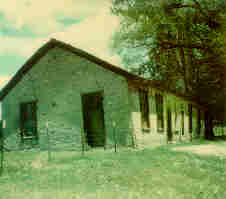PONY EXPRESS STATIONS
IN WHITE PINE
COUNTY, NEVADA


Major Howard Egan, while scouting for the Mormon leader, Brigham Young, originally laid out the east - west trail which entered Nevada at Pleasant Valley. James H. Simpson, a Captain in the Corps of Topographical Engineers, was ordered to map a road from Camp Floyd in Utah to Genoa in 1859. He recommended that Egan's trail be used for future travel because it had a good supply of grass and water. This trail was later used by the Overland Mail and Telegraph Company from 1861 to 1869 using the old established Pony Express stations and the trail became known as the Overland Trail.
| Click here
for A SHORT HISTORY OF THE PONY EXPRESS AND OVERLAND MAIL IN WHITE PINE COUNTY, NEVADA |
Pony Express stations in White Pine County, proceeding from the Eureka County line to the Utah border are:
A recent finding is that sometime
between 1866 and 1869 Jacobs Well Station increased in importance and became one of the
final division stations on the Overland Stage. Charles Haynes was assigned as the last
Division Agent on the only remaining Overland Stage division between Jacobs Well and
Schell Creek Station in Nevada. With completion of the transcontinental railroad in
February of 1869, the Overland Stage ceased operations.
Jacobs Well Station was used for about the last five months of the Pony Express operation,
but is especially noteworthy because it was used longer than any station of this era in
Nevada! Jacobs Well's longevity was due to its' strategic location on the Central Overland
Road within the South Fork Humboldt River drainage, also known as Huntington Valley.
With the discovery of the fabulous
silver deposits in the White Pine Mining District, it also was used as a station during
the worldwide 1868 "Rush to White Pine" on the only toll road from Elko to the
new boomtown of Hamilton, Nevada. For a period of about six months unrecorded hordes of
people visited this Station on their stampede to strike it rich at White Pine. Historical
evidence indicates Jacobs Well Station was abandoned sometime after 1871 when White Pine
mining operations had started their inevitable decline. Jacobs Well Station was gradually
forgotten and faded away into the enveloping sea of sagebrush.
PROLOGUE
Through fortunate circumstances, as the result of an oil and gas exploration project and
some detective work by government employees, Jacobs Well Station was found on public land
in the Summer of 1992. The University of Nevada, Reno became interested in this almost
pristine historic site, and with the joint commitment of the Federal and State
governments, businesses, and volunteer workers an archaeological investigation program
began in 1995 and continued in 1996 and 1997.
Other Pony Express and Overland Stage era sites that have been scientifically investigated have resulted in mere hundreds of total artifacts; the Jacobs Well collection, a perpetual public resource that will be available for display and scholarly research, numbers well over 5,000.
The artifacts at Jacobs Well Station
represent the comforts of civilization that one could expect to find in a town in the 1860
to 1870 period. Until proven otherwise claim is made that Jacobs Well is and forever will
be the most scientifically valuable station site of this era that has ever been studied!
When a final year of excavation and subsequent study is completed at this site, enough
information about this Station will be available to prepare publications for distribution
to Pony Express enthusiasts and scholars.
The site
sketch and photo shows the features at Jacobs Well Station that were investigated in
the Summer of 1996. No well has been located on the site, but the bottom of a wood-lined
earthen cistern has not been found yet. The main building was first thought to be a long,
narrow structure built with rock; however, about midsummer as the archaeological
excavation progressed it was determined the rock debris was from an immense collapsed
fireplace.
The 16 by 25 foot building instead was constructed of vertical, wooden posts placed palisade-style that had been burnt off at ground level after the site was abandoned. There also is firm evidence that two blacksmith shops were located here at different times. The earlier blacksmith operation used charcoal produced in an earthen kiln at the site, while the more recent smithy had bituminous coal, most likely hauled in from the Elko railhead, to produce superior coke fuel for the forge.
The Pony Express established their station here in 1860 and the Overland Mail & Telegraph Company also began using Uncle Billy's trading post as a station in 1861 until they ceased operating in 1869. The area has been referred to as "Fort Ruby" and "Camp Ruby."
Ruby Valley, White Pine County, Nevada - Ruby Valley Pony Express Station - photo taken in 1944 - Only a small amount of ruins exist in 1998. Picture courtesy of Joe Nardone 5/2/98
Many Mormons grew barley, oats and grains, but charged prices that the Overland Mail Company chose not to pay, instead opting to grow their own grain for their stock on 1000 acres just east of the trading post. Potatoes, beets and other vegetables were grown on the company's farm for use of Uncle Billy's customers and the other stations on the east and west. Travelers were served baked goods, fresh meat, fish, fowl and vegetables and the Ruby Valley Station became one of the most popular rest stops between western Nevada and Salt Lake City.
The Overland Mail Company sold off the farm after 1869. The settlement of Hobson formed around the old Overland Mail Company's farm, which had become a large ranch and the Hobson post office operated between 1902 and 1914. Paher says the ranch uses a few buildings remaining from the 1860's for storage, but the barracks from the old fort were torn down, leaving only foundations to be seen. Rock ruins remain of the old Overland Stage Station and only a spring and historical marker show the site of the old Pony Express station.
A Pony Express Station added between Ruby Station and Butte Station in 1861 to
support the Overland Mail and Overland Stage and the Pony Express. It operated 1861 to
1869. Rock foundation ruins and a well remain at the site.
The station's thirty-foot long walls were made of logs, sandstone and limestone compacted with mud. The roof was constructed by the use of split cedar trees. Porthole size windows supplied light. There was a corral made from rails and a shed of some kind.
While discussing the original Butte Station, Paher states, "A canvas partition cut the inside into unequal parts with one section containing two bunks, standing bedsteads of poles, all heaped up with ragged coverings, probably army blankets and buffalo robes. Underneath were saddles, harnesses and straps. Clothes and several sacks of grain and food kept off the floor by logs. The uneven unswept floor was a sea of mud in one corner because part of a spring oozed through one wall. A fireplace occupied half of another wall." Only the foundation remains.
The station was also used by the Overland
Mail and Telegraph Company from 1861 to 1869.
In 1865, Egan was a mining camp that contained stores, a blacksmith shop, post office, a school and several houses. In 1870, the town had 67 residents, including Andrus Davis, the telegraph operator.
Road building, recycling of building materials and mining operations have obliterated much of the site. The Egan Canyon Cemetery is located about one quarter of a mile away. Unique wooden grave fences joined with wooden dowels show the craftsmanship of the unknown builder. (see Ghost Towns) The Egan Canyon site is located on private property.
Fort Schellbourne is located south of the Cherry Creek road at the junction of US 93 and S. R. 2, then 3 miles east. 39 miles north of Ely in Steptoe Valley.
The area may be named for Major A. J. Schell as Schell Creek was named before the Station was built by the Pony Express. This section of the country has a long history of Indian fighting, and first served as a Pony Express Station; later as a fort for the US troops. Many buildings were moved to Cherry Creek. Schellbourne now serves as the headquarters for a ranch. A small cemetery lies near the ruins of the town with Burke family members and three men who were murdered in 1865 interred in it. Pictures and picture links can be found on the cemetery page.

This building has been identified as perhaps being the old Schellbourne Post
Office, far back right.
Photo courtesy of Sunny Martin.
A rock outline of the building remains. This Pony Express Station is located inside the present-day Goshute Indian Reservation.

Links to Pony Express related pages
Pony Express Home Station
by Tom Crews - an excellent, informative Pony Express site. It has information
regarding all aspects of the Pony Express and should not be missed.
Pony Express Stations in Nevada
White Pine Cemeteries and Burials
White Pine Historical & Archealogical Society
White Pine Historical and Archaeological Society
P.O. Box 1117
Ely, NV 89301
webpanda.com
Pages designed by
Shaputis Enterprises